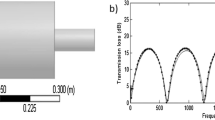Abstract
Several solutions for multiple-point acoustic magnitude equalization of medium-sized enclosed spaces are analyzed comparatively. The main design steps are discussed: derivation of the room acoustic prototype, an average of the transfer functions obtained for individual listening points; synthesis of the equalizing filter; characterization of the resulting equalized acoustic chain. First, two approaches for designing the equalizer are presented: a classical synthesis method, which employs the Levinson–Durbin algorithm (LD), and a newer one, based on a genetic algorithm (GA) tailored for the synthesis of FIR filters. Frequency warping able to “stretch” the narrow low-frequency octaves is also considered. A novel experimental setup is proposed to ensure that the equalized acoustic chain’s characterization is performed at the same signal level as the un-equalized chain. A new Figure-of-Merit is introduced that allows for a simple yet intuitive comparison of various equalizing solutions considering both the frequency characteristic and the spatial spread between multiple audition points. Finally, experimental data are presented and analyzed: four equalization solutions (LD- or GA-based, with or without frequency warping) were derived for each of three medium-sized enclosed spaces, with audition areas between 36 and 105 m2, and reverberation times ranging from 0.7 to 3.8 s.










Similar content being viewed by others
REFERENCES
H. Kuttruff, Room Acoustics (Spon Press, London, 2009).
F. Everest, The Master Handbook of Acoustic, 5th ed. (McGraw Hill, New York, 2009).
J. Hatziantoniou and J. Mourjopoulos, J. Audio Eng. Soc. 52 (9). 883 (2004).
M. Karjalainen, T. Paatero, J. Mourjopoulos, and P. Hatziantoniou, in Proc. Workshop on Applications of Signal Processing to Audio and Acoustics (New York, 2005), p. 183.
T. P. M. Karjalainen, EURASIP J. Adv. Signal Process., Art. No. 058358 (2007).
J. Mourjopoulos, Audio Eng. Soc. 42 (11), 884 (1994).
A. Mertins, T. Mei, and M. Kallinger, IEEE Trans. Speech Audio Process. 5 (4), 325 (2010).
S. Elliot and P. Nelson, J. Audio Eng. Soc. 37 (11), 899 (1989).
Y. Haneda, S. Makino, and Y. Kaneda, IEEE Trans. Speech Audio Process. 5 (4), 325 (1997).
S. Cecchi, L. Palestini, P. Peretti, F. Piazza, and A. Carini, in Proc. 6th Int. Symp. on Image and Signal Processing and Analysis (Salzburg, 2009).
A. Carini, S. Cecchi, F. Piazza, I. Omiciuolo, and G. Sicuranza, IEEE Trans. Audio, Speech, Lang. Process. 20 (1), 122 (2012).
S. Cecchi, L. Palestini, P. Peretti, L. Romoli, F. Piazza, and A. Carini, J. Audio Eng. Soc. 59 (3), 110 (2011).
S. Cecchi, L. Romoli, F. Piazza, B. Bank, and A. Carini, in Proc. Audio Engineering Society Int. Convention (Berlin, 2014).
S. Bharitkar and C. Kyriakakis, in Proc. 36th IEEE Asilomar Conf. (Pacific Grove, 2002).
S. Bharitkar and C. Kyriakakis, in Proc. Workshop on the Applications of Signal Processing to Audio and Acoustics (New York, 2001).
S. Bharitkar and C. Kyriakakis, IEEE Trans. Audio, Speech, Lang. Process. 15 (2), 542 (2007).
S. Cecchi, A. Carini, and S. Spors, Appl. Sci. 8 (1), 1 (2017).
S. Neely and J. Allen, J. Acoust. Soc. Am. 66 (1), 165 (1979).
J. Mourjopoulos, P. Clarkson, and J. Hammond, in Proc. Int. Conf. on Acoustics, Speech, and Signal Processing ICASSP’82 (Paris, 1982).
A. A. Mal’tsev, R. O. Maslennikov, A. V. Khoryaev, and V. V. Cherepennikov, Acoust. Phys. 51 (2), 195 (2005).
L. Lu and B. Zhang, Acoust. Phys. 52 (6), 701 (2006).
V. D. Koshur and M. S. Fadeeva, Acoust. Phys. 53 (6), 742 (2007).
F. Toole, Sound Reproduction. Loudspeakers and Rooms (Elsevier, Oxford, 2008).
E. Szopos, M. Neag, I. Saracut, V. Popescu, and M. Topa, Circuits, Syst. Signal Process. 35 (1), 253 (2016).
A. Oppenheim, D. Johnson, and K. Steiglitz, Proc. IEEE 52 (2), 299 (1971).
A. Härmä, M. Karjalainen, L. Savioja, V. Välimäki, U. K. Laine, and J. Huopaniemi, J. Audio Eng. Soc. 48 (11), 1011 (2000).
Nonuniform Sampling, Theory and Practise, Ed. by F. Marvast (Kluwer Acad. Publ., 2001).
L. Davis, Handbook of Genetic Algorithms, Ed. by V. N. Reinhold (Michigan, 1991).
A. Farina, Proc. AES 122nd Convention (Vienna, 2007).
A. Farina, AURORA. http://pcfarina.eng.unipr.it/Aurora_XP/index.htm.
I. Mateljan, ARTA. http://www.artalabs.hr/.
Author information
Authors and Affiliations
Corresponding author
Rights and permissions
About this article
Cite this article
Fărcaș, C.A., Szopos, E., Sărăcuț, I. et al. Experiments on Multiple-point Room Equalization Applied to Medium-sized Enclosed Spaces. Acoust. Phys. 67, 537–552 (2021). https://doi.org/10.1134/S106377102105002X
Received:
Revised:
Accepted:
Published:
Issue Date:
DOI: https://doi.org/10.1134/S106377102105002X




